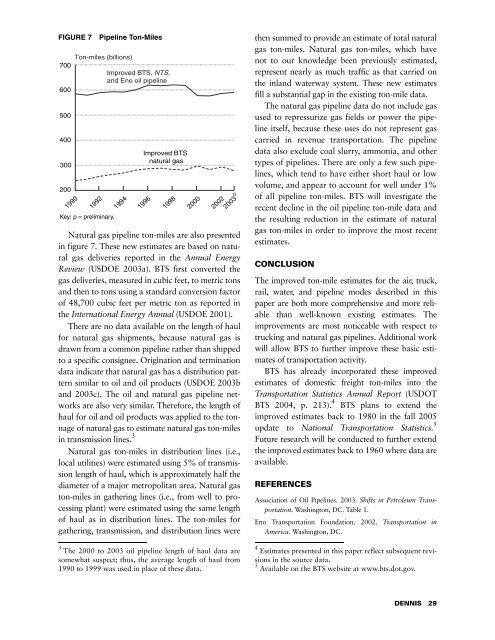journal of transportation and statistics - Research and Innovative ...
journal of transportation and statistics - Research and Innovative ...
journal of transportation and statistics - Research and Innovative ...
Create successful ePaper yourself
Turn your PDF publications into a flip-book with our unique Google optimized e-Paper software.
FIGURE 7 Pipeline Ton-MilesTon-miles (billions)700Improved BTS, NTS,<strong>and</strong> Eno oil pipeline60050040030020019901992Key: p = preliminary.1994Improved BTSnatural gas199619982000Natural gas pipeline ton-miles are also presentedin figure 7. These new estimates are based on naturalgas deliveries reported in the Annual EnergyReview (USDOE 2003a). BTS first converted thegas deliveries, measured in cubic feet, to metric tons<strong>and</strong> then to tons using a st<strong>and</strong>ard conversion factor<strong>of</strong> 48,700 cubic feet per metric ton as reported inthe International Energy Annual (USDOE 2001).There are no data available on the length <strong>of</strong> haulfor natural gas shipments, because natural gas isdrawn from a common pipeline rather than shippedto a specific consignee. Origination <strong>and</strong> terminationdata indicate that natural gas has a distribution patternsimilar to oil <strong>and</strong> oil products (USDOE 2003b<strong>and</strong> 2003c). The oil <strong>and</strong> natural gas pipeline networksare also very similar. Therefore, the length <strong>of</strong>haul for oil <strong>and</strong> oil products was applied to the tonnage<strong>of</strong> natural gas to estimate natural gas ton-milesin transmission lines. 3Natural gas ton-miles in distribution lines (i.e.,local utilities) were estimated using 5% <strong>of</strong> transmissionlength <strong>of</strong> haul, which is approximately half thediameter <strong>of</strong> a major metropolitan area. Natural gaston-miles in gathering lines (i.e., from well to processingplant) were estimated using the same length<strong>of</strong> haul as in distribution lines. The ton-miles forgathering, transmission, <strong>and</strong> distribution lines were3 The 2000 to 2003 oil pipeline length <strong>of</strong> haul data aresomewhat suspect; thus, the average length <strong>of</strong> haul from1990 to 1999 was used in place <strong>of</strong> these data.p20022003then summed to provide an estimate <strong>of</strong> total naturalgas ton-miles. Natural gas ton-miles, which havenot to our knowledge been previously estimated,represent nearly as much traffic as that carried onthe inl<strong>and</strong> waterway system. These new estimatesfill a substantial gap in the existing ton-mile data.The natural gas pipeline data do not include gasused to repressurize gas fields or power the pipelineitself, because these uses do not represent gascarried in revenue <strong>transportation</strong>. The pipelinedata also exclude coal slurry, ammonia, <strong>and</strong> othertypes <strong>of</strong> pipelines. There are only a few such pipelines,which tend to have either short haul or lowvolume, <strong>and</strong> appear to account for well under 1%<strong>of</strong> all pipeline ton-miles. BTS will investigate therecent decline in the oil pipeline ton-mile data <strong>and</strong>the resulting reduction in the estimate <strong>of</strong> naturalgas ton-miles in order to improve the most recentestimates.CONCLUSIONThe improved ton-mile estimates for the air, truck,rail, water, <strong>and</strong> pipeline modes described in thispaper are both more comprehensive <strong>and</strong> more reliablethan well-known existing estimates. Theimprovements are most noticeable with respect totrucking <strong>and</strong> natural gas pipelines. Additional workwill allow BTS to further improve these basic estimates<strong>of</strong> <strong>transportation</strong> activity.BTS has already incorporated these improvedestimates <strong>of</strong> domestic freight ton-miles into theTransportation Statistics Annual Report (USDOTBTS 2004, p. 213). 4 BTS plans to extend theimproved estimates back to 1980 in the fall 2005update to National Transportation Statistics. 5Future research will be conducted to further extendthe improved estimates back to 1960 where data areavailable.REFERENCESAssociation <strong>of</strong> Oil Pipelines. 2003. Shifts in Petroleum Transportation.Washington, DC. Table 1.Eno Transportation Foundation. 2002. Transportation inAmerica. Washington, DC.4 Estimates presented in this paper reflect subsequent revisionsin the source data.5 Available on the BTS website at www.bts.dot.gov.DENNIS 29
















